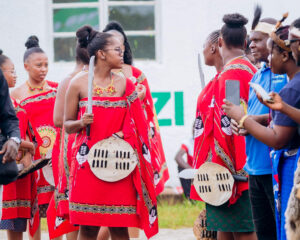By Bonface Orucho
Africa is establishing a legal framework for its cultural heritage through laws drafted by its own jurists.
In early July, a historic gathering in Lomé, Togo brought together African legal minds to begin shaping what could become the continent’s most comprehensive reference on cultural heritage law.
According to Harry Mokoka, an African studies scholar at the University of Pretoria, “By crafting our own legal references, we’re not only strengthening domestic systems, we’re also changing how heritage is understood and valued globally.”
“This is part of a broader continental movement toward legal sovereignty, an assertion that we have the expertise, the mandate, and the lived experience to define what justice looks like for our heritage.”
The workshop, co-hosted by UNESCO and the École du Patrimoine Africain, convened 18 jurists from across the continent to develop a legal foundation for protecting and reclaiming Africa’s cultural wealth.
For decades, restitution efforts have operated within legal frameworks built far from the communities whose histories were taken.
African artefacts, scattered across European museums and private collections, have been subject to return negotiations governed by treaties and conventions shaped without African perspectives.
“Most return negotiations today are bound by conventions that reflect colonial-era assumptions, not African values or priorities,” Mokoka explained.
That imbalance is now being actively addressed. Across the continent, national policies are laying the groundwork for a unified restitution agenda.
Since 2018, more than 20 African countries have adopted or drafted national restitution frameworks, according to UNESCO.
South Africa is among the latest, having unveiled a draft National Policy on the Repatriation and Restitution of Human Remains and Heritage Objects in May 2025. It formalises the state’s commitment to heritage justice.
The policy outlines government-led mechanisms to identify, negotiate, and return cultural items and ancestral remains held abroad.
It comes amid ongoing repatriation efforts, including the return and reburial of 58 Khoi and San ancestral remains in South Africa’s Northern Cape. These remains, previously held at the Iziko Museums in Cape Town and sourced from both local and foreign institutions, are now being returned to descendant communities, including the Nama!, Xun, Khwe, Griqua, and Korana.
Ghana has also taken a proactive stance, establishing a National Focal Team on Restitution and Repatriation under the Ministry of Tourism, Arts and Culture.
The team is tasked with researching international best practices and engaging directly with museums and institutions abroad.

Regional bodies such as ECOWAS have introduced shared restitution protocols. At the continental level, the African Union has elevated restitution into a pillar of justice and sovereignty under its Agenda 2063 blueprint.
“We’re not just asking for artefacts to come home. We’re defining the legal ground on which they return,” said Kevin Nyambega of the Kenya Cultural Centre. “This is about authorship—about ensuring that our laws speak with our own voice.”
This shared voice emerges from a common challenge: inherited legal systems that overlook African understandings of value, memory, and custodianship.
According to Nyambega, “Sacred objects, human remains, and ceremonial artefacts often carry meanings far deeper than ownership, yet existing legal systems tend to reduce them to commodities or museum property.”
“That’s why the shift underway is as philosophical as it is procedural.”
That shift is already reshaping both policy and practice.
Community forums are reframing restitution as a process of healing, not just retrieval. In May, Kenya hosted a UNESCO-backed Conference on Heritage Authenticity in Nairobi, where local communities advocated for oral traditions, ancestral custodianship, and spiritual frameworks to anchor emerging heritage law.
In June, a hybrid dialogue on reparations at the University of Pretoria foregrounded ancestral memory and ritual as essential to justice, beyond financial or material return.
Restitution efforts are accelerating across the continent, with more artefacts being returned from foreign institutions.
In May, Finland returned a 17th-century royal katakle (stool) to Benin, a symbolic yet significant act. Nigeria continues to recover Benin Bronzes from Germany, the Netherlands, and the United States.
Yet, behind each return lies a deeper question: under what terms are these artefacts coming back, and whose frameworks are shaping those terms.
Some countries are beginning to answer that through law.
In Kenya, the National Museums’ legal team is integrating customary law into restitution claims, particularly for sacred objects held in European collections.
In Ethiopia, the return of centuries-old religious manuscripts, Ge’ez texts looted during the 1868 Battle of Magdala, has sparked national debates on stewardship and responsibility. These include psalters, gospel books, and liturgical manuscripts central to the Ethiopian Orthodox tradition.
In Rwanda, a heritage charter in development aims to protect not only physical artefacts but also songs, rituals, and other forms of intangible culture.
“What we’re seeing is the emergence of African legal consciousness around heritage,” says Fatoumata Diakité, a cultural law expert based in Mali. “This is not just about what returns, but how it returns, and who gets to write that story.”
International institutions are also beginning to take note.
UNESCO’s Africa Week 2025 in Paris spotlighted African-led legal reform as central to future restitution partnerships.
France has opened the door to negotiations with Niger, acknowledging for the first time that legal and historical redress for colonial violence may go beyond symbolic gestures.
Still, challenges remain.
“Many countries lack the archival infrastructure, museum capacity, or legal resourcing to absorb large-scale returns,” Mokoka noted.
“And while the Lomé initiative marks a major step, scaling its vision across 54 countries, each with different legal traditions, will require long-term coordination.”
But the groundwork is being laid.
With support from institutions such as OHADA, UNIDROIT, and a network of African and European universities, the Lomé working group is expected to publish the first volume of the reference work by 2026.
If realised, it could become a cornerstone of Africa’s cultural legal architecture, guiding everything from bilateral negotiations to national policy design.
“Restitution isn’t only about artefacts,” Diakité adds. “It’s about restoring legal dignity. Restoring the power to name, to protect, and to decide.”
bird story agency
Africa is developing a comprehensive legal framework for its cultural heritage with input from African jurists.
In a historic meeting in Lomé, Togo, experts began drafting laws to protect and reclaim Africa's cultural wealth, which historically has been governed by frameworks lacking African perspectives.
This is part of a broader movement towards legal sovereignty, allowing African voices to define justice for heritage.
Many African countries, like South Africa and Ghana, are creating restitution policies to support the return of artefacts held abroad, reflecting a commitment to heritage justice.
Efforts include the return of human remains in South Africa and the establishment of national teams like Ghana's for restitution negotiations.
Regional bodies and the African Union have also prioritized restitution as part of their Agenda 2063 blueprint.
Community efforts are reshaping the restitution landscape, emphasizing healing through oral traditions and ceremonial frameworks.
This African legal consciousness is influencing policy and practices, ensuring artefacts return under frameworks that reflect African values. International bodies, including UNESCO, are acknowledging these reforms, indicating stronger restitution partnerships ahead.
Despite these advances, challenges like infrastructure and legal resourcing remain. However, Africa is laying the groundwork for a unified legal architecture by 2026, potentially guiding national policies and negotiations.
Restitution extends beyond artefacts, aiming to restore legal dignity by empowering African countries to protect and decide on their cultural heritage.






